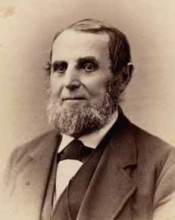Austin Bearse facts for kids
Quick facts for kids
Austin Bearse
|
|
|---|---|
 |
|
| Born | April 3, 1808 |
| Died | December 2, 1881 (aged 73) |
| Occupation | sea captain |
| Known for | abolitionism |
Austin Bearse (1808-1881) was a brave sea captain from Cape Cod. He is famous for helping people escape slavery in the years before the American Civil War. He played a big part in the movement to end slavery.
Contents
Early Life of Austin Bearse
Austin Bearse was born in Barnstable, Massachusetts, on April 3, 1808. When he was young, he sometimes worked on ships that traded enslaved people. These ships sailed off the coast of South Carolina. He saw firsthand how terribly enslaved people were treated.
Years later, he wrote in his book that families were torn apart. He said it was like choosing calves or pigs from a group of farm animals. Often, the families of those being taken were allowed to spend the night on the ship. In the morning, Austin had the sad job of telling them it was time to say goodbye. He remembered that "the shrieks and cries of grief at these times were enough to make anyone's heart ache."
Because of these experiences, Austin Bearse decided to fight against slavery. He became an abolitionist. He kept working as a sailor but refused to sail south of the Mason–Dixon line. This line separated the free states from the slave states.
Austin Bearse and the Fight Against Slavery
In 1847, Austin Bearse began his rescue missions. Two Quaker women, Abigail and Lydia Mott, asked for his help. He secretly brought an enslaved man named George Lewis from Albany to Boston. In Boston, George was reunited with his daughter, who had also escaped.
Austin helped George find a job. Then, Reverend Leonard Grimes from the Twelfth Baptist Church raised money. This money was used to buy the freedom of George's wife and other children. This was the first of many rescues Austin Bearse helped with.
Joining the Boston Vigilance Committee
After the Fugitive Slave Act of 1850 was passed, Austin joined the Boston Vigilance Committee. This group helped enslaved people escape to freedom. They were connected to the Underground Railroad. Around this time, Austin moved to City Point in South Boston.
From 1851, he worked as a "harbor spy" for the Committee. He watched for people who tried to catch escaped enslaved people. He also collected money for the group until 1855. Austin worked with other important abolitionists. These included Thomas Wentworth Higginson, Wendell Phillips, Lewis Hayden, and William Ingersoll Bowditch.
Daring Rescues on the Moby Dick
Austin Bearse used his 36-foot sloop boat, named the Moby Dick, for many brave rescues. In one case, the Committee hired him to rescue Sandy Swain. Sandy was an escaped enslaved person on a ship called the Florence. This ship was docked at Fort Independence.
Austin brought several white abolitionists and Black dock workers with him. He convinced the captain of the Florence to let Sandy go. As they sailed away, they dressed Sandy like a fisherman. This way, he would not look suspicious when they landed at City Point House. From there, Sandy was driven to a safe house. The next morning, he continued his journey to Canada, where he would be truly free.
On another occasion, Austin was asked to rescue an escaped enslaved person from the Sally Ann ship. He could not find enough men to go with him quickly. So, he and his brother decided to try the rescue alone. To trick the other captain, Austin tied jackets and hats to his own ship's railing. From a distance, it looked like he had a large crew.
He then sent his brother in a small rowboat to pick up the person hiding on the Sally Ann. The captain of the Sally Ann seemed fooled. He handed the person over to the Bearse brothers. They brought him to South Boston and let him stay in Austin's home. From there, this freed person also continued on the Underground Railroad to Canada.
In 1853, Austin Bearse was interviewed by Harriet Beecher Stowe. This happened at the office of The Liberator newspaper. She was gathering information for her book, A Key to Uncle Tom's Cabin.
Death and Legacy
Near the end of his life, Austin Bearse wrote a book. It was called Reminiscences of the Fugitive Slave-Law Days in Boston (1880). This book shared his memories of helping people escape slavery.
He passed away on December 2, 1881. He was buried in the Beechwood Cemetery in Centerville, Massachusetts. The Austin Bearse House in Centerville was built around 1691. It is now part of the Centerville Historic District. It stands as a reminder of his important work.
See Also

